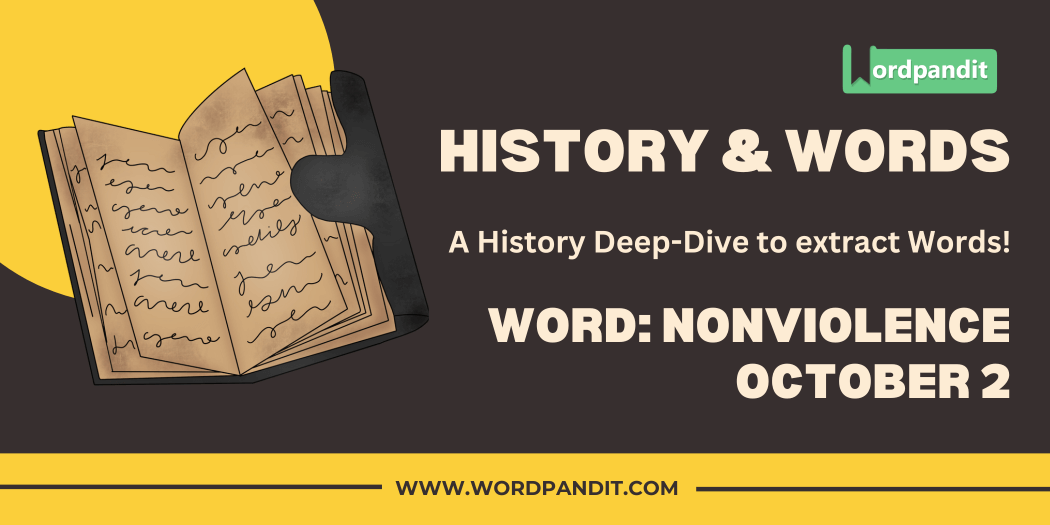History & Words: 'Nonviolence' (October 2)
Welcome to 'History & Words.' 🌟 I'm Prashant, founder of Wordpandit and the Learning Inc. Network. This series combines my passion for language learning with historical context. Each entry explores a word's significance on a specific date, enhancing vocabulary while deepening understanding of history. Join me in this journey of words through time.
🔍 Word of the Day: Nonviolence
Pronunciation: /nɒnˈvaɪələns/ (non-VYE-uh-luhns)
🌍 Introduction
On October 2, we commemorate the birth of Mohandas Karamchand Gandhi, born in 1869, a figure whose name has become synonymous with the concept of nonviolence. This date, now recognized as the International Day of Non-Violence by the United Nations, serves as a powerful reminder of the enduring impact of Gandhi's philosophy and its continuing relevance in our world.
The word "nonviolence" encapsulates a profound ethical and political principle that has shaped movements for social change across the globe. It represents not merely the absence of violence, but an active approach to conflict resolution and social transformation that rejects the use of physical force or coercion.
Gandhi's application of nonviolence, which he termed "satyagraha" (holding onto truth), became a cornerstone of India's independence movement and inspired civil rights leaders worldwide. The power of this concept lies in its ability to challenge oppressive systems while maintaining moral high ground, often winning public sympathy and support in the process.
🌱 Etymology
The term "nonviolence" is a direct translation of the Sanskrit word "ahimsa," which literally means "non-injury" or "non-harming." The English word is a compound of "non" (not) and "violence" (from Latin "violentia," meaning vehemence, impetuosity). While the concept has ancient roots in various philosophical and religious traditions, its use as a distinct political strategy gained prominence in the 20th century, largely due to Gandhi's influential work.
📖 Key Vocabulary
- 🔑 Satyagraha: A form of nonviolent resistance developed by Gandhi, literally meaning "holding onto truth."
- 🔑 Civil disobedience: The active, professed refusal to obey certain laws, demands, or commands of a government.
- 🔑 Passive resistance: A method of nonviolent protest where individuals do not physically resist, but refuse to cooperate with an oppressor.
- 🔑 Ahimsa: The principle of nonviolence toward all living things in Indian religions and philosophies.
- 🔑 Boycott: A form of nonviolent protest involving the withdrawal of support from a product, organization, or country.
🏛️ Historical Context
The concept of nonviolence has deep roots in various philosophical and religious traditions. In ancient India, the principle of ahimsa was central to Jainism, Buddhism, and certain schools of Hindu thought. Similarly, pacifist ideas can be found in early Christian teachings and in the works of thinkers like Leo Tolstoy.
However, it was in the 20th century that nonviolence emerged as a powerful political strategy. Gandhi's successful use of nonviolent resistance against British colonial rule in India marked a turning point. His methods demonstrated that moral force, when consistently applied, could challenge even the most entrenched systems of oppression.
The influence of Gandhi's philosophy spread far beyond India. In the United States, Martin Luther King Jr. drew heavily on Gandhian principles in leading the Civil Rights Movement. The Montgomery Bus Boycott and the Selma to Montgomery marches are iconic examples of nonviolent action in the face of racial discrimination.
In South Africa, Nelson Mandela, while not always adhering to strict nonviolence, incorporated elements of the philosophy in the struggle against apartheid. The end of apartheid through largely peaceful means stands as another testament to the power of nonviolent resistance.
⏳ Timeline
- 1869: Birth of Mohandas Karamchand Gandhi
- 1906: Gandhi first uses satyagraha in South Africa
- 1930: Salt March in India, a major nonviolent protest against British salt monopoly
- 1955-1956: Montgomery Bus Boycott led by Martin Luther King Jr.
- 1960: Greensboro sit-ins, nonviolent protests against racial segregation in the US
- 1989: Nonviolent revolutions in Eastern Europe lead to the fall of communist regimes
- 2007: UN General Assembly establishes October 2 as the International Day of Non-Violence
🌟 The Day's Significance
October 2, Gandhi's birthday, holds special significance in the history of nonviolence. In 2007, the United Nations General Assembly established this date as the International Day of Non-Violence, recognizing Gandhi's role in spreading the philosophy globally and its continued relevance in the modern world.
The choice of this date reflects the profound impact Gandhi's ideas have had on global politics and social movements. It serves as an annual reminder of the potential of nonviolent action to bring about significant social and political change.
Gandhi's approach to nonviolence was not passive; it was an active and often confrontational strategy. He believed that by refusing to cooperate with unjust laws and systems, while also refusing to respond with violence, oppressed people could reveal the moral bankruptcy of their oppressors and ultimately change the system.
The day also highlights the ongoing challenges in implementing nonviolent strategies in a world often dominated by conflict and force. It prompts reflection on how nonviolent principles can be applied to contemporary issues, from international conflicts to domestic social justice movements.
💬 Quote
"Nonviolence is a weapon of the strong." - Mahatma Gandhi
This quote encapsulates Gandhi's belief that choosing nonviolence requires greater courage and moral strength than resorting to violence.
🔮 Modern Usage and Reflection
In the 21st century, the concept of nonviolence continues to evolve and find new applications. Modern movements like the Arab Spring, the Occupy movement, and various environmental protests have incorporated elements of nonviolent resistance.
The rise of digital technology has also introduced new forms of nonviolent action, such as online activism and digital civil disobedience. These developments raise questions about how the principles of nonviolence can be effectively applied in an increasingly interconnected and virtual world.
🏛️ Legacy
The legacy of nonviolence as a political strategy is complex and far-reaching. Its success in various historical contexts has established it as a legitimate and powerful tool for social change. The United Nations' recognition of the International Day of Non-Violence is a testament to its global significance.
However, debates continue about the effectiveness and limitations of nonviolence in different political and cultural contexts. Critics argue that nonviolence may not always be sufficient against extremely oppressive regimes or in situations of acute crisis.
🔍 Comparative Analysis
When Gandhi introduced his concept of satyagraha, it was seen as a radical departure from conventional methods of political struggle. Today, while still respected, nonviolence is often viewed more critically. Modern discourse tends to analyze its effectiveness in specific contexts rather than viewing it as a universal solution. This shift reflects a more nuanced understanding of the complexities involved in social and political change.
💡 Did You Know?
🎓 Conclusion
The concept of nonviolence, as embodied in the life and work of Mahatma Gandhi and celebrated on October 2, remains a powerful force in shaping our approach to conflict and social change. While its application continues to evolve, the core principle of achieving justice without resorting to violence endures as a beacon of hope and a challenge to build a more peaceful world.
📚 Further Reading
- 📘 "The Politics of Nonviolent Action" by Gene Sharp
- 📗 "Why Civil Resistance Works: The Strategic Logic of Nonviolent Conflict" by Erica Chenoweth and Maria J. Stephan
- 📙 "The Search for a Nonviolent Future: A Promise of Peace for Ourselves, Our Families, and Our World" by Michael N. Nagler

